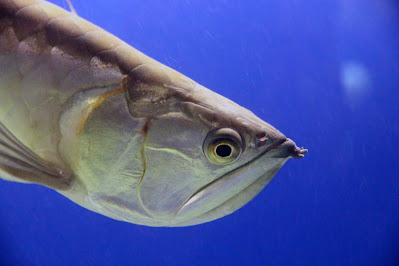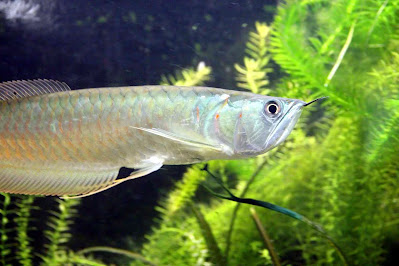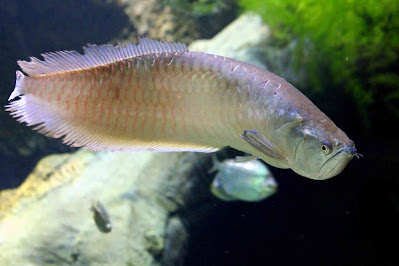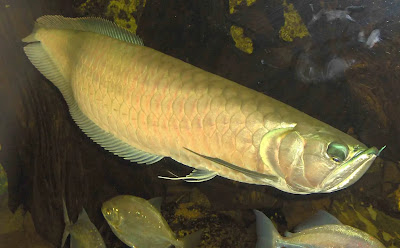Silver Arowana (Osteoglossum Bicirrhosum)
Silver Arowana, also called the Monkey Fish or Dragon Fish, is a freshwater fish that originated in South America.

It is known for its large size and hunting ability. This fish is one of the most iconic around and also can be a prized possession of any hobby aquarist.
While in general, it is not recommended for the beginner aquarist, this fish may make a fantastic addition to an experienced keeper’s fish tank.
I have condensed the important information down into a facts table shown below before we explore our complete guide to Silver Arowanas:
Category | Rating |
Care Level: | Difficult |
Temperament: | Semi-aggressive |
Color Form: | Silver |
Silver Arowana Lifespan: | 10-15 Years |
Size: How big do Silver Arowanas get? | Up to 3 feet |
Diet: | Carnivore |
Family: | Osteoglossidae |
Minimum Tank Size: | 250 Gallons |
Tank Set-Up: | Freshwater: Rocks and Plants |
Compatibility: | Moderate |
Kingdom: | Animalia |
Phylum: | Chordata |
Class: | Actinopterygii |
Order: | Osteoglossiformes |
Family: | Osteoglossidae |
Genus: | Osteoglossum |
Species: | Bicirrhosum |
Overview of Silver Arowana
It is a freshwater and bony fish that is native to the South American Amazon River Basin.
It is also known as the Monkey Fish and Dragon Fish, and occasionally misspelled as Arahuana and Arawana. This fish is adored by so many hobby aquarists.
Silver Arowana is a powerful and strong swimming fish and can be very aggressive at times. These are predator fish that can grow up to 4 feet in size, and they weigh in excess of 6kg.
When Silver Arowana is raised in captivity, you can expect an Arowana to have a lifespan of 10 to 15 years.
If you have ever encountered them in the wild environment, you’ll notice their unique hunting style. They have a huge leap that allows them to hunt other animals on low-level branches.
They even have the power to survive short periods of time out of the water by using their swim bladder.
In general, if you’re searching for an Arowana, the Silver Arowanas are the least restricted by import regulations. Because of this reason, they are the cheapest variant of Arowanas available.
Their precarious nature, giant size, and long lifespan can make them a fish that only experienced aquarists should consider having.
Senses
Arowanas have two great sensory systems referred to as barbels located at the tip of the lower jaw, which they can use to sense.
With the help of this great sensor system, they can easily capture their prey located on the surface of the water, even in complete darkness.
They also have the ability to use their sense of sight, which is excellent, to locate the prey.
Communication
They can communicate with the electrical signals produced by certain muscles and also with sensory barbels.
Range/Habitat
The Silver Arowana fish inhabits in Rupununi and Essequibo systems of the Guianas, slow-moving to still tributaries, lagoons, and backwaters in the Amazon Basin.
Status: It is listed as a Least Concern on the IUCN Red List.
Silver Arowanas’ Appearance

TheSilverArowana fish is highly demanded, usually the crowning jewel in any collection.
They are silver colored and large in size. They can grow up to 4 feet in the wild environment, but when kept in captivity, you can expect them to grow up to around 3 feet in length.
In terms of weight, the typical Arowana may gain a weight of around 4.6kg (10lb) when they are fully mature.
The most distinguishing characteristic of Silver Arowana is its jawline, affectionately known as a ‘drawbridge’. Their mouth is almost vertical.
Their mouth is at the top of the body and opens in three pieces. A lot of oral bones bear the palate, teeth, including the jaw, pharynx, and tongue. Large, pearly-silver scales cover their whole bodies.
These pearly scales shift to shades of blue, red, and green as the fish gets older. They have anal fins and dorsal which are nearly fused with the caudal fin. The males are slimmer.
They have a longer anal fin. Arowanas have a pair of barbells at the extremity of the bottom jaw. Whilst the adults have silver, juveniles have blue glints and an orange-yellow bar.
In their body, you’ll notice they have large pearl-like silver scales throughout their entire body. When they are juveniles, these scales may have a blueish tint to them.
When viewed from the side, their long, sleek body seems flat, and when you look very closely, you’ll see their dorsal fin is almost fused with the caudal fin.
The females are usually ‘thicker’, with males being more slender and having a bigger anal fin.
As for the Silver Arowana growth rate, they begin out very small (almost 4 inches after their egg sack is consumed), however, they grow exceptionally fast.
They can grow 2 inches every month during their first year, so you have to make ensure they are well fed and have a lot of room space inside their tank.
Silver Arowana Fish Price
In terms of Silver Arowana price, this is usually the cheapest type of Arowana fish available in the market and can cost you around $40 for a small piece.
General Behavior
For an oversized Silver Arowana fish, they’ll be surprisingly skittish. They can get afraid of sudden movements, for instance, when turning the lights on or when you approach your aquarium quickly.
You must ensure to keep your Arowanas in a fish tank which is placed in a silent and low-traffic area. This will prevent them from getting startled every time you walk past your aquarium.
When looking at your Dragon Fish, you’ll see they like to spend most of their time swimming close to the surface of the aquarium water.
However, it is to be noted that Silver Arowanas are one kind of notorious jumpers. It’s been claimed that they have the ability to jump up to 3 meters high.
They are most likely to jump when they are placed in an aquarium that is very small for them, or they are new to an aquarium.
When they are placed in an aquarium that’s too small for the Arowanas, they will try to jump to free themselves again and again. Even though the fish tank is covered, they’ll still jump and can get injured themselves when bouncing off the lid.
This is why it is very crucial you only place Arowanas in a suitably large tank.
Habitat and Tank Requirements

Silver Arowana Tank Size
As we have mentioned in the appearance section above of this article, Silver Arowanas are strong swimmers and large fish.
This fish quickly outgrows most hobby aquarist fish tanks and needs a tank that is at least 250 gallons in capacity.
Juveniles may be raised in a smaller tank of 60 gallons capacity; however, they can quickly require moving out into a larger aquarium.
If they are not moved into a big-sized tank, you can quickly start to have so many problems with your Arowana fish, most notably reduced lifespan and body deformation.
The substrate must consist of small, fine gravel. The aquarium should be sparingly planted and must have plenty of open room for them to move around in.
If you are interested in decorating your aquarium, you can do so with Rockwood, Sturdy Plants, and Driftwood. Those plants that have weak roots should be avoided because they are more likely to be dislodged by the Silver Arowana fish.
Lastly, it is to be noted that Silver Arowanas are notorious jumpers, so you require a very heavy tank cover to stop them from jumping out of the fish tank.
Tank Conditions
Your goal is to keep the aquarium water temperature anywhere between 75-82°F. Again, the water pH levels should be between 6.5-7.5, and tank water must be soft to moderately hard.
The Silver Arowanas are specifically susceptible to low quality of water; in addition to weekly tank water changes of 25%, a very strong water filtration is required.
Unlike other freshwater fish, Silver Arowanas are very tolerant of changes in such conditions, but you must aim to keep the water within the tolerance levels outlined above.
Special Tank Tip
Arowanas are spooked very easily, therefore, you have to keep the aquarium in a silent and low-traffic area.
Silver Arowanas Compatibility and Fish Tank Mates
Compatibility
The first and foremost thing to keep in mind about Silver Arowanas is that they’re predator fish. It has implications for Arowana’s compatibility and the fish that will share a tank with them.
Let’s begin by watching them as juvenile fish.
You also have to know that when they are young, Arowanas can be kept and raised together. It is suggested that you simply keep 6 or more Silver Arowanas together in your tank.
The little ones are protected by it from being highly bullied by the Arowanas that are relatively larger in size.
Now let’s check out the ideal tank mates and compatibility for adult Silver Arowanas.
this is not surprising to believe that finding ideal tank mates is often difficult. They’re being targeted by some aggressive fish because of the size of their body.
On the other side of the scale, tiny fish are not suitable tank mates because they generally end up being eaten by Silver Arowanas, since they are predator fish.
But, there are still plenty of breeds that can live with the Arowanas.
When assessing fish to keep with your Arowana, remember these three general rules:
1. You have to place the Arowana in the fish tank first.
2. Newly searched fish should also be big enough so that they can not be eaten by the large Arowana.
3. You have to find peaceful yet slightly aggressive fish to keep them with Silver Arowanas.
Silver Arowana Tank Mates
Some examples of this would be Oscars, Knifefish, Green Terrors, Parrot Cichlid, Large Plecostomus, catfish, and Angelfish.
Also, remember that individual fish temperaments may vary hugely, for always have a backup plan if they do not ‘get along’.
Keeping Arowanas Together
If you intend to keep several adult Arowanas together in your fish tank, do it cautiously.
They usually do not live well together. If you’re insistent, you must keep a minimum of 6 of them together and keep them in a big natural pond (or a similar-sized aquarium ).
Diet and Feeding Requirements
What is the best food for Silver Arowana?
The Silver Arowanas are normally considered to be carnivores, but again, they are occasional omnivores.
In the wild environment, they can consume a wide range of prey, including snails, rabbits, small fish, frogs, large insects, and even snakes!
Although if given Arowanas an option, their food of choice is normally crustaceans and small fish.
They have a distinctive hunting style. Because of the position of Arowana’s mouth, they can swim just below the water level before jumping up out of the tank or pond water to catch their prey.
They can also catch small fish by swimming under them and scooping them small fish up.
When keeping these fish, you would like to ensure their diet is as close to what they would eat in the wild environment.
Arowanas prefer to have a meat-based diet, which may include: shrimp, crab, crickets, krill, beef heart, earthworms, and crustaceans.
You may also provide them with feeder fish. It will allow you to look at the hunt, which will be very absorbing.
If you want to provide Arowana feeder fish, I would simply suggest you breed your own feeder fish. This way, you will make sure the breeder fish are fit and healthy.
If you are going to buy feeder fish from online or pet stores, you can’t ensure they are active and healthy, and high risk is involved in bringing disease into your aquarium.
If you are worried about the relatively expensive fresh meat, you may feed your Silver Arowanas frozen food to try and also keep the costs down. I have even read somewhere that some Arowanas are trained to eat pellets, however, this isn’t common.
Lastly, it is to be mentioned that juvenile Arowanas are fussy eaters.
You should just feed them live/fresh food at this level in their life cycle. As they start to grow (above 8 to 9 inches), you may introduce them to frozen foods such as earthworms.
Arowana Breeding: How To Breed Arowana
Arowanas can usually lay their eggs at the beginning of the flood season in the wild (December to January).
Before spawning, they can build a nest and pair off. Before the male takes the eggs in their mouth, the female will then lay the eggs into the nest. It is to be noted that Silver Arowanas are mouthbrooders.
These eggs are orange/red and are reasonably big.
The males can carry the eggs for almost 50 days, where they grow from an egg to larvae, to fry. At around 5 weeks after hatching, they will leave the father’s mouth and begin to search for food.
It is very unfortunate to say that there are only a few breeding success stories in household aquariums.
These success stories are reported from ponds/tanks that are larger than 500 gallons. That is why it is usually not recommended to try to breed them from home aquariums.
The large portion of available Arowana to buy nowadays is sourced from Asian fish farms.
How To Avoid Common Diseases and Treat Them
Silver Arowana fish can generally get into fights with other breeds that lead to injuries. This type of fish is very skittish, which may compromise their immune system.
These common factors will make Silver Arowana susceptible to common pond and aquarium diseases like fin rot, eye cloud, ich, body slime, velvet, and tail rot.
Avoid Species-Specific Diseases
Apart from the more general diseases, there are some others that you may need to look for:
Anchor Worms: As we mentioned above, avoid using feeder fish which are not been quarantined and not treated for these anchor worms.
If you closely notice Silver Arowana scratching and darting (particularly in the gill area), treat them with an antibiotic that is suitable for killing fish lice and anchorworms.
You may also need to raise the amount of oxygen and the flow of air in the fish tank, since these worms can reduce the capacity of the gills.
Drop Eye: Fish that are in aquariums that are very small will develop other problems and stunted growth. It causes eye problems that are caused by looking at the bottom of the fish tank.
This situation occurs mostly in the case of farm-bred silver arowanas, which are found in fish shops. It involves a layer of fat developing at the top of the fish’s eye, providing their eyes a drooping appearance.
The best solution to control this problem is to avoid it permanently by keeping Silver Arowana in bigger tanks. It is also a very good idea to feed the fish live foods that float on the surface of the aquarium so that they can look up often.
Insofar as part of the treatment, place the Silver Arowana in a tank where it can’t look out from the tank walls, and always look upward for its food.
Best antibiotics: Find pond-safe antibiotics and also other medications formulated, especially for the Arowanas.
In a pinch, you may also try antibiotics that are really safe and secure for scaleless fish. Although this fish’s scales are big and robust, their looseness may be another problem, particularly as the fish gets older.
Treatments to avoid: Always avoid medications that are not specifically created for Arowanas or those medications that have a warning against using them with this fish breed.
In some particular cases, you may need to take the fish to a veterinarian who is able to treat fish diseases.
Food recommendations: Use live foods continuously. If the fish tolerates sticks or pellets, look to see if you can get any medicated versions.
Isolation or Hospital Tank? No, but you may need to understand how to isolate and transport the fish to take them to a veterinarian for treatment.
Is the Silver Arowana Right For Your Aquarium? (Summary)
Frankly speaking, the Silver Arowana is not a fish that is recommended for beginners.
Because of its long life expectancy and large size, I recommend that only experienced aquarists take this challenge.
This needs a giant tank (at least 250 gallons in capacity), and searching for suitable tank mates for them could be a challenging task.
These fish are considered to be carnivores, and they eat large quantities of food. Therefore, it should also be taken into consideration before buying them from the market. Also, you can prepare your fish food to reduce costs and save money.
If you are interested in getting an Arowana, always try to purchase them when they are a minimum of 8 inches long. In this time, they have started to grow and are much harder, which means you can have a better chance of successfully keeping the Arowanas.
Hey, have you already kept Silver Arowanas in your aquarium? In the comments section, let me know about your experience with them.
